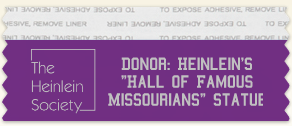Six stories and a ribbon are tied together in today’s Scroll.
(1) Keith Kato, President of The Heinlein Society, says donors to Heinlein’s “Hall of Famous Missourians” bust who attend Worldcon and/or Loscon are eligible for this ribbon:
(2) The Planetary Society’s Emily Lakdawalla offers a first look at New Horizons’ Pluto and Charon images ,which a team member calls “baffling in a very interesting and wonderful way.”
There are other bodies in the solar system similar in size to Charon: Ariel, Umbriel, and Oberon. They, too, have some craters, as well as chasms. Yesterday, people were saying Charon looked more heavily cratered, hence, older. Seen at higher resolution, Charon is looking younger than we thought. Now I really, really wonder, if we could look more closely at Uranus’ moons, would we see more youthful surfaces than we thought?
The other most amazing image of the press briefing was Pluto, seen at high resolution. It is in the bright area that we have been informally calling the “heart” but which now has a still informal but slightly more official name: Tombaugh regio, named for the discoverer of Pluto. It is located near the southern end of Tombaugh Regio, near the terminator, where the Sun glances across the landscape at a low angle, highlighting topography. And oh my goodness, what topography.
(3) A Rancor costume at Comic-Con inspired this close analysis by Tech Crunch writer Greg Kumparak.
Comic Con is full of Vaders, Boba Fetts, and Storm Troopers. But how many people can say they’ve roamed the show in an ultra detailed, kind-of-terrifying Rancor costume?
Just one — special effects artist Frank Ippolito.
Built in just a month by Ippolito and a team of artists along with our friends over at Tested, the costume is about as intense as they get.
My favorite trick of the whole project: as you may note, the Rancor’s eyes don’t happen to fall in a place that offers the wearer much of a view to the outside world. So how do they keep him from running into walls and stepping on small children? There’s a camera hidden in one of the nostrils; inside the costume, he’s wearing a pair of goggles that beams that camera feed to his eyes.
The post includes a motion GIF of Rancor in action and a link to a video about how the costume was made.
(4) Vox Day has a new project in the works:
The good news. I will publish a book this fall, most likely in September, and it will be a non-fiction book entitled SJWS ALWAYS LIE: How to Defend Yourself From the Thought Police. The meme is rapidly spreading, more and more people are understanding that the First Law of SJW is both a truism and a reliable metric, and everyone needs to know how to defend themselves against an SJW swarm. And based on who is writing it, the Foreword may well be the best part.
(5) Entirely coincidentally, Alexandra Erin found renewed inspiration for two new humor pieces.
“Interview With A Pratt” – July 14
Q: You attribute what you call your tactical genius to your love of wargames. Forgive my ignorance, but how exactly does playing Warhammer make you an expert on 4GW? Don’t the rules only model conventional warfare?
A: That’s your problem exactly. The “rules”. Who wrote those precious rules? Who told you that you have to follow them? The use of Fourth Generation Warfare transcends the tabletop as it transcends all battlefields. 4GW is psychological. It changes from situation to situation. It adapts.
Q: How does it adapt to tabletop gaming?
Sometimes it means licking your opponent’s miniatures so he will not want to touch them.
“What’s Up With John Z. Upjohn” – July 15
Since it seems unlikely that The Freedom of Liberty will see the light of day anytime soon, [John Z. Upjohn] asked me if I would share it, so at least part of it might find an audience.
Jon P. Johnson was not a hateful man. There was no room for hate in heart, not with all the love of freedom crammed in there. But he was a man, all man, and he had the same natural reaction to homosexuals as every other man.
The comforting weight of the rifle in his hands was comforting to his hands. It was a custom made version of the latest model the finest weaponsmiths on Ceanndana could turn out: the Garand Turismo Mark III with the double extended clip and a polycarbonite stock with a gunmetal gray finish expertly covered over in stained walnut.
Not satisfied with the machine results, he had insisted on rifling the barrel by hand himself. He’d been shooting since before he could walk. What machine knew more about rifles than he did? His bold and unconventional and boldly unconventional choice had resulted in a weapon that was accurate to a range of approximately seven meters, but he was quite sure that no other weapon was quite as accurate at that range.
(6) Not sf, but a compelling literary event prompted Joseph Bentz, Professor of English at Azusa Pacific University, to answer readers who are unhappy with Harper Lee’s Go Set A Watchman:
[First of four points]
- I believe it is a mistake to see Atticus Finch as simply older and more racist than he was in Mockingbird. Instead, I think he is essentially a different character in Watchman than the reconceived Atticus in Mockingbird. In other words, there are two Atticuses, created by the author to fit the needs of the particular book.
Why is Atticus Finch so different in Watchman than he is in Mockingbird? The publication history of the two novels is crucial in answering that question. Lee submitted Watchman to her editor in the 1950’s. The editor, enjoying the childhood flashbacks the most, urged Lee to write a novel set 20 years earlier, focusing on those elements of the story. In doing so, I believe Lee created an alternate version of Atticus Finch. He is a different character in Mockingbird than in Watchman, though carved from the same materials.
Mockingbird and Watchman are not really sequels or prequels to one another. They are separate treatments of the same core material. Even the outcome of the trial that is central to Mockingbird is different when it is referred to in Watchman. Lee never expected to publish both books. She did not need to keep the characters completely consistent between the two books. She had the freedom to adjust the characters to meet the needs of the particular book. One implication of this for readers is that if they don’t like the Atticus in Watchman, that doesn’t need to “ruin” the Atticus in Mockingbird for them. They can choose whichever conception of the character they like best.
The Scout character in Watchman, who is more commonly called Jean Louise, also strikes me as significantly different from the Scout character in Mockingbird. It’s not simply that she is twenty years older in Watchman, it’s that I don’t think she is simply a grown-up version of the Mockingbird Scout. She is a reconceived character. She is not radically different in the two books, but different in ways that novelists often change the personalities and other traits of their characters in later drafts of the stories.



 When
When